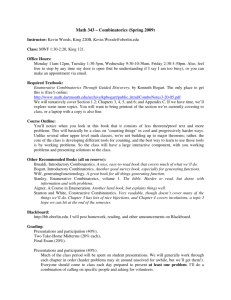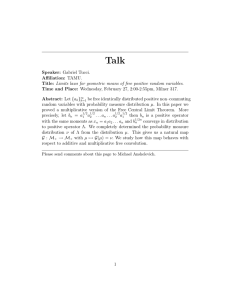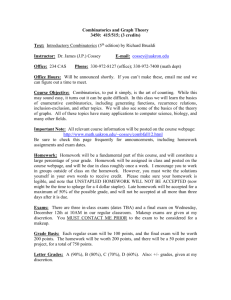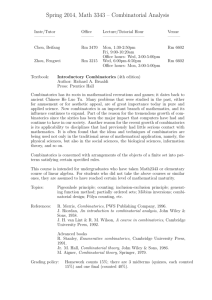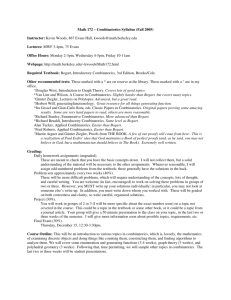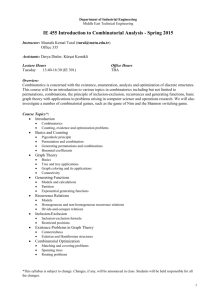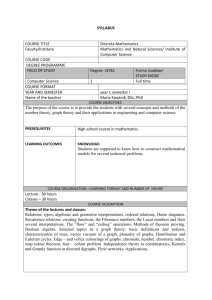Probability and combinatorics Michael Anshelevich May 1, 2012 Texas A&M University
advertisement
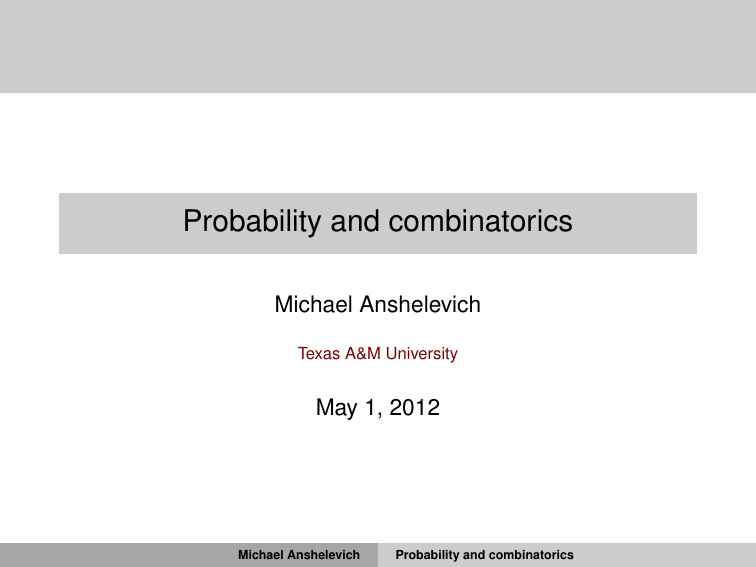
Probability and combinatorics
Michael Anshelevich
Texas A&M University
May 1, 2012
Michael Anshelevich
Probability and combinatorics
Probability spaces.
(Λ, M, P ) = measure space.
Probability space: P a probability measure, P (Λ) = 1.
Algebra A = L∞ (Λ, P ) of bounded random variables.
R
E[X] = X dP = expectation functional on A.
For each real-valued X, have µX = probability measure on R
defined by
Z
Z
f (x) dµX (x) =
f (X) dP = E[f (X)]
Λ
R
for f ∈ C0 (R).
µX = distribution of X.
Michael Anshelevich
Probability and combinatorics
Independence.
More generally, if X1 , X2 , . . . , Xn random variables,
µX1 ,X2 ,...,Xn = measure on Rn = joint distribution.
Definition. X, Y are independent if
µX,Y = µX ⊗ µY (product measure)
i.e.
E[f (X)g(Y )] = E[f (X)]E[g(Y )]
Remark. If X, Y independent
Z
Z
f (t) dµX+Y (t) = f (x + y) dµX,Y (x, y)
Z
Z
= f (x + y) d(µX ⊗ µY ) = f (t) d(µX ∗ µY ).
So in this case, µX+Y = µX ∗ µY .
Michael Anshelevich
Probability and combinatorics
Fourier transform.
Definition. Fourier transform
Z
FX (θ) = eiθx dµX (x) = E[eiθX ]
Lemma. If X, Y independent,
FX+Y (θ) = FX (θ)FY (θ).
Proof.
E[eiθ(X+Y ) ] = E[eiθX eiθY ] = E[eiθX ]E[eiθY ]
Michael Anshelevich
Probability and combinatorics
Combinatorics.
Z
FX (θ) =
eiθx dµX (x) =
∞
X
(iθ)n
n=0
Z
mn =
n!
mn (X),
xn dµX (x) = E[X n ].
{m0 , m1 , m2 , . . .} = moments of X.
For X, Y independent, mn (X + Y ) complicated. But:
FX+Y (θ) = FX (θ)FY (θ),
log FX+Y (θ) = log FX (θ) + log FY (θ).
Denote `X (θ) = log FX+Y (θ).
Michael Anshelevich
Probability and combinatorics
Cumulants.
`X (θ) =
∞
X
(iθ)n
n=1
n!
cn ,
{c1 , c2 , c3 , . . .} = cumulants of X.
cn (X + Y ) = cn (X) + cn (Y ).
Relation between {mn }, {cn }?
A set partition
{(1, 3, 4), (2, 7), (5), (6)} ∈ P(7).
Michael Anshelevich
Probability and combinatorics
Moment-cumulant formula.
Proposition.
mn =
X Y
c|B| .
π∈P(n) B∈π
mean
m1 = c1 ,
c1 = m1
m2 = c2 + c21 ,
c2 = m2 − m21
c31 ,
c3 = m3 −
` = log F,
F = e` ,
m3 = c3 + 3c2 c1 +
mn+1 =
n X
n
k=0
Michael Anshelevich
k
3m2 m21
variance
+
2m31
F 0 = `0 F.
ck+1 mn−k .
Probability and combinatorics
Central limit theorem.
Theorem. Let {Xn : n ∈ N} be independent, identically
distributed, mean 0, variance v.
E[Xn ] = 0,
Let
Sn =
E[Xn2 ] = v.
X1 + X2 + . . . + Xn
√
.
n
Then the moments of Sn converge to the moments of the
normal distribution N (0, v).
Michael Anshelevich
Probability and combinatorics
Central limit theorem.
Proof. For each k,
ck (αX) = αk ck (X).
ck (Sn ) = ck
X1 + X2 + . . . + Xn
√
n
n
= √ k ck (X1 ).
( n)
(k = 1) c1 (X1 ) = 0, c1 (Sn ) = 0.
(k = 2) c2 (X1 ) = v, c2 (Sn ) = v.
n
(k > 2) k/2 → 0, ck (Sn ) → 0.
n
In the limit, get whichever distribution has
(
v, k = 2,
ck =
0, otherwise.
P
Check: normal distribution. Note mn = π∈P2 (n) v n/2 .
Michael Anshelevich
Probability and combinatorics
Operators.
H = real Hilbert space, e.g. Rn .
HC = its complexification (Cn ).
HC⊗n = HC ⊗ HC ⊗ . . . ⊗ HC
= symmetric tensor product
= Span ({h1 ⊗ h2 ⊗ . . . ⊗ hn , order immaterial})
with the inner product
hh1 ⊗ . . . ⊗ hn , g1 ⊗ . . . ⊗ gn i =
X
h1 , gσ(1) . . . hn , gσ(n)
σ∈Sym(n)
(degenerate inner product).
Michael Anshelevich
Probability and combinatorics
Creation and annihilation operators.
Symmetric Fock space
F(HC ) =
∞
M
HC⊗n = CΩ ⊕ HC ⊕ HC⊗2 ⊕ HC⊗3 . . . ,
n=0
Ω = vacuum vector.
−
For h ∈ H, define a+
h , ah on F(HC )
a+
h (f1 ⊗ . . . ⊗ fn ) = h ⊗ f1 ⊗ . . . ⊗ fn ,
n
X
a−
(f
⊗
.
.
.
⊗
f
)
=
hfi , hi f1 ⊗ . . . ⊗ fˆi ⊗ . . . ⊗ fn ,
n
h 1
i=1
a−
h (f )
= hf, hi Ω
creation and annihilation operators.
Michael Anshelevich
Probability and combinatorics
Operator algebra.
+ ∗
Check: a−
h = (ah ) adjoint.
−
So Xh = a+
h + ah = self-adjoint.
a+ , a− do not commute:
+
+ −
a−
h ag − ag ah = hg, hi .
But Xh , Xg commute.
A = Alg {Xh : h ∈ H} = commutative algebra.
Define the expectation functional on it by
E[A] = hAΩ, Ωi .
(A, E) = probability space.
Michael Anshelevich
Probability and combinatorics
Wick formula.
D
E
−
+
−
+
−
E[Xh1 Xh2 . . . Xhn ] = (a+
+
a
)(a
+
a
)
.
.
.
(a
+
a
)Ω,
Ω
h1
h1
h2
h2
hn
hn
X
Y
=
hhi , hj i .
π∈P2 (n) (i,j)∈π
Therefore:
(
khk2 , k = 2,
ck (Xh ) =
0,
otherwise,
and so Xh ∼ N (0, khk2 ).
If h ⊥ g, the Xh , Xg are independent.
Michael Anshelevich
Probability and combinatorics
